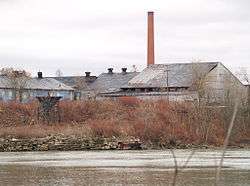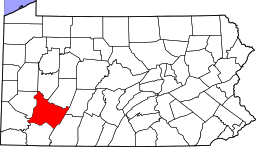Arnold, Pennsylvania
| Arnold, Pennsylvania | |
|---|---|
| City | |
|
Abandoned factory along the Allegheny River | |
| Motto: Proud City of Proud People | |
 Arnold, Pennsylvania Location within the state of Pennsylvania | |
| Coordinates: 40°34′39″N 79°45′52″W / 40.57750°N 79.76444°WCoordinates: 40°34′39″N 79°45′52″W / 40.57750°N 79.76444°W | |
| Country | United States |
| State | Pennsylvania |
| County | Westmoreland |
| Settled | 1781 |
| Incorporated (borough) | 1896 |
| Incorporated (city) | 1939 |
| Government | |
| • Mayor | Karen Peconi |
| Area | |
| • Total | 0.8 sq mi (2.0 km2) |
| Population (2010) | |
| • Total | 5,157 |
| • Density | 6,446.25/sq mi (2,578.5/km2) |
| Time zone | Eastern (EST) (UTC-5) |
| • Summer (DST) | EDT (UTC-4) |
| Website | Official website |
Arnold is a city in Westmoreland County, Pennsylvania, United States, within the Pittsburgh metropolitan area. The population was 5,157 at the 2010 Census.
History
Present-day Westmoreland County was part of the hunting reserves of the Iroquois Indians. Americans began to penetrate the area in the 1750s, and circa 1781 Robert McCrea purchased the land on which Arnold is situated. William Jack acquired the property and later passed it on to Wilson Jack. The area around Arnold was first settled in 1852 by Major Andrew Arnold, who grew up in Kittanning. Arnold was part of New Kensington until it was separately incorporated as a borough in January 1896, and as a third-class city in 1939.
Geography
Arnold is located on the eastern shore of the Allegheny River, northeast of Pittsburgh. According to the United States Census Bureau, the city has a total area of 0.8 square miles (2.1 km2), of which 0.7 square miles (1.8 km2) is land and 0.1 square miles (0.26 km2) (6.41%) is water.
Demographics
| Historical population | |||
|---|---|---|---|
| Census | Pop. | %± | |
| 1900 | 1,428 | — | |
| 1910 | 1,818 | 27.3% | |
| 1920 | 6,120 | 236.6% | |
| 1930 | 10,575 | 72.8% | |
| 1940 | 10,898 | 3.1% | |
| 1950 | 10,263 | −5.8% | |
| 1960 | 9,437 | −8.0% | |
| 1970 | 8,174 | −13.4% | |
| 1980 | 6,853 | −16.2% | |
| 1990 | 6,113 | −10.8% | |
| 2000 | 5,667 | −7.3% | |
| 2010 | 5,157 | −9.0% | |
| Est. 2015 | 4,988 | [1] | −3.3% |
| [2][3] | |||
As of the census[4] of 2000, there were 5,667 people, 2,589 households, and 1,439 families residing in the city. The population density was 7,706.6 people per square mile (2,956.8/km²). There were 2,976 housing units at an average density of 4,047.1 per square mile (1,552.8/km²). The racial makeup of the city was 84.84% White, 12.76% African American, 0.18% Native American, 0.14% Asian, 0.02% Pacific Islander, 0.26% from other races, and 1.80% from two or more races. Hispanic or Latino of any race were 1.13% of the population.
There were 2,589 households of which 23.6% had children under the age of 18 living with them, 37.5% were married couples living together, 14.4% had a female householder with no husband present, and 44.4% were non-families. 39.9% of all households were made up of individuals and 20.7% had someone living alone who was 65 years of age or older. The average household size was 2.15 and the average family size was 2.90.
In the city the population was spread out with 21.6% under the age of 18, 6.9% from 18 to 24, 28.7% from 25 to 44, 20.2% from 45 to 64, and 22.6% who were 65 years of age or older. The median age was 40 years. For every 100 females there were 86.5 males. For every 100 females age 18 and over, there were 82.9 males.
The median income for a household in the city was $26,190, and the median income for a family was $32,569. Males had a median income of $31,164 versus $23,953 for females. The per capita income for the city was $16,631. About 14.0% of families and 17.7% of the population were below the poverty line, including 30.8% of those under age 18 and 10.3% of those age 65 or over.
Landmarks
Notable landmarks in Arnold have included:
- Arnold Station, established in 1867, which was Arnold’s railroad stop. It was so named because the land on which it was built was given by the Arnold Family.[5]
- The Chambers Glass Company, which opened in 1891, was at the time the first, best equipped, and most efficient glass plant in the country.[6]
- George Moore Home, which was built with 17 rooms, but has since been demolished.
- The Morris Davis home stands across from where the George Moore home stood. Morris Davis built it very precisely, rejecting many loads of lumber if they had knotholes or any defects. It was one of the very first homes in the area that had electricity.
- The Hartley Howard Home was another home of that time, which still stands today, serving as apartments.
- Eiler Hall was a fashionable site for parties, dances, banquets and public shows. It is now a parking lot for city employees of the Municipal Building.
- The Edna Hotel was named after George Moore‘s daughter Edna in the late 1800s. It was the meeting place for all of Arnold at the turn of the 20th century.
- The John Fedan Store began as a rental for other merchants. When that did not follow through, Fedan started his own business with a small hardware store and later added a furniture and appliance store.
- The Arnold Drug Store opened in 1898 and was also the post office location at the time.
W.R. Gott was one of the leading merchants of his time in the city. He opened his own grocery store in 1914 at the age of twenty and added appliances to his line in 1920. It was the largest electric appliance dealer in Allegheny Valley and was Tri-Boro’s leading grocery store. In 1921 he built his own store and then expanded it in 1932. In 1936, he took over the Arnold Traffic Store, which had been a general store, a meeting place, a temporary church, an office, an amateur playhouse and a nightclub became W.R. Gott’s Furniture Store. In 1973, the building was sold to Goodwill and it was later sold to Arnold Furniture, who still own it today.
Growth
The city has grown to include many family owned businesses, churches, volunteer ambulance and fire departments, the Arnold Police Department, YMCA, Roosevelt Park and Arnold Chamber of Commerce.
Education
Arnold is served by the New Kensington–Arnold School District, which includes six schools in New Kensington and Arnold: Valley High School, a middle school, and four elementary schools. The current middle school was Arnold's high school prior to the merger of the two districts.
Notable people
References
- ↑ "Annual Estimates of the Resident Population for Incorporated Places: April 1, 2010 to July 1, 2015". Retrieved July 2, 2016.
- ↑ "Census 1990" (PDF). Census.gov. Retrieved 2015-09-18.
- ↑ "Incorporated Places and Minor Civil Divisions Datasets: Subcounty Resident Population Estimates: April 1, 2010 to July 1, 2012". Population Estimates. U.S. Census Bureau. Archived from the original on 17 June 2013. Retrieved 11 December 2013.
- ↑ "Profile of General Demographic Characteristics: 2000 - Geographic area: Arnold city, Pennsylvania" (PDF). Censtats.census.gov. Retrieved 2015-09-18.
- ↑ The Woman's Club of New Kensington. Lore of Yore. New Kensington, Pennsylvania: Buhl Brothers Printing,1986.
- ↑ The Woman's Club of New Kensington. Lore of Yore. New Kensington, Pennsylvania: Buhl Brothers Printing,1986.

